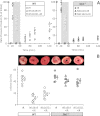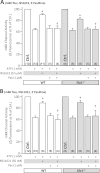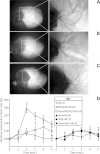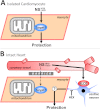A non-cardiomyocyte autonomous mechanism of cardioprotection involving the SLO1 BK channel
- PMID: 23638385
- PMCID: PMC3628382
- DOI: 10.7717/peerj.48
A non-cardiomyocyte autonomous mechanism of cardioprotection involving the SLO1 BK channel
Abstract
Opening of BK-type Ca(2+) activated K(+) channels protects the heart against ischemia-reperfusion (IR) injury. However, the location of BK channels responsible for cardioprotection is debated. Herein we confirmed that openers of the SLO1 BK channel, NS1619 and NS11021, were protective in a mouse perfused heart model of IR injury. As anticipated, deletion of the Slo1 gene blocked this protection. However, in an isolated cardiomyocyte model of IR injury, protection by NS1619 and NS11021 was insensitive to Slo1 deletion. These data suggest that protection in intact hearts occurs by a non-cardiomyocyte autonomous, SLO1-dependent, mechanism. In this regard, an in-situ assay of intrinsic cardiac neuronal function (tachycardic response to nicotine) revealed that NS1619 preserved cardiac neurons following IR injury. Furthermore, blockade of synaptic transmission by hexamethonium suppressed cardioprotection by NS1619 in intact hearts. These results suggest that opening SLO1 protects the heart during IR injury, via a mechanism that involves intrinsic cardiac neurons. Cardiac neuronal ion channels may be useful therapeutic targets for eliciting cardioprotection.
Keywords: Cardiac neurons; Ischemia; Large conductance potassium channel; NS11021; NS1619; Preconditioning; Reperfusion.
Figures







Similar articles
-
The Slo(w) path to identifying the mitochondrial channels responsible for ischemic protection.Biochem J. 2017 Jun 9;474(12):2067-2094. doi: 10.1042/BCJ20160623. Biochem J. 2017. PMID: 28600454 Free PMC article. Review.
-
Activation of big conductance Ca(2+)-activated K (+) channels (BK) protects the heart against ischemia-reperfusion injury.Pflugers Arch. 2009 Mar;457(5):979-88. doi: 10.1007/s00424-008-0583-5. Epub 2008 Sep 2. Pflugers Arch. 2009. PMID: 18762970
-
cGMP-Elevating Compounds and Ischemic Conditioning Provide Cardioprotection Against Ischemia and Reperfusion Injury via Cardiomyocyte-Specific BK Channels.Circulation. 2017 Dec 12;136(24):2337-2355. doi: 10.1161/CIRCULATIONAHA.117.028723. Epub 2017 Oct 19. Circulation. 2017. PMID: 29051185
-
Pharmacological options to protect the aged heart from ischemia and reperfusion injury by targeting the PKA-BK(Ca) signaling pathway.Exp Gerontol. 2014 Aug;56:99-105. doi: 10.1016/j.exger.2014.03.029. Epub 2014 Apr 13. Exp Gerontol. 2014. PMID: 24727217
-
Brief structural insight into the allosteric gating mechanism of BK (Slo1) channel 1.Can J Physiol Pharmacol. 2019 Jun;97(6):498-502. doi: 10.1139/cjpp-2018-0516. Epub 2018 Dec 5. Can J Physiol Pharmacol. 2019. PMID: 30517027 Review.
Cited by
-
BKCa Channels as Targets for Cardioprotection.Antioxidants (Basel). 2020 Aug 17;9(8):760. doi: 10.3390/antiox9080760. Antioxidants (Basel). 2020. PMID: 32824463 Free PMC article. Review.
-
Inhibition of BKCa channels protects neonatal hearts against myocardial ischemia and reperfusion injury.Cell Death Discov. 2022 Apr 7;8(1):175. doi: 10.1038/s41420-022-00980-z. Cell Death Discov. 2022. PMID: 35393410 Free PMC article.
-
The cardioprotective compound cloxyquin uncouples mitochondria and induces autophagy.Am J Physiol Heart Circ Physiol. 2016 Jan 1;310(1):H29-38. doi: 10.1152/ajpheart.00926.2014. Epub 2015 Oct 30. Am J Physiol Heart Circ Physiol. 2016. PMID: 26519034 Free PMC article.
-
The Slo(w) path to identifying the mitochondrial channels responsible for ischemic protection.Biochem J. 2017 Jun 9;474(12):2067-2094. doi: 10.1042/BCJ20160623. Biochem J. 2017. PMID: 28600454 Free PMC article. Review.
-
Multidimensional Regulation of Cardiac Mitochondrial Potassium Channels.Cells. 2021 Jun 19;10(6):1554. doi: 10.3390/cells10061554. Cells. 2021. PMID: 34205420 Free PMC article. Review.
References
-
- Armour JA. Histamine-sensitive intrinsic cardiac and intrathoracic extracardiac neurons influence cardiodynamics. American Journal of Physiology. 1996;270:R906–R913. - PubMed
-
- Armour JA. Intrinsic cardiac neurons involved in cardiac regulation possess alpha 1-, alpha 2-, beta 1- and beta 2-adrenoceptors. Canadian Journal of Cardiology. 1997;13:277–284. - PubMed
Grants and funding
LinkOut - more resources
Full Text Sources
Other Literature Sources
Molecular Biology Databases
Research Materials
Miscellaneous

